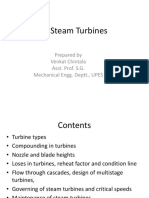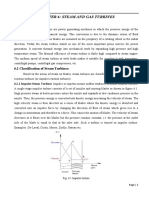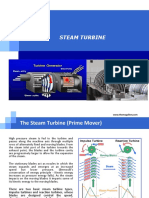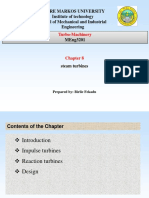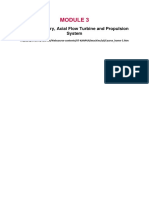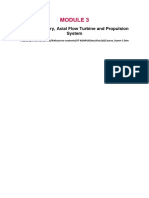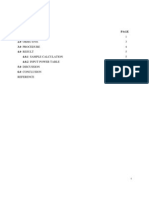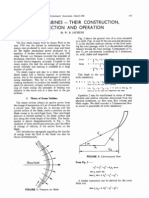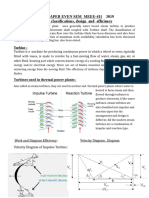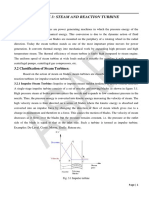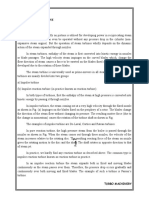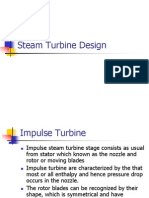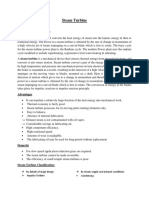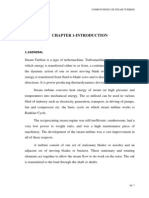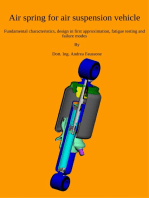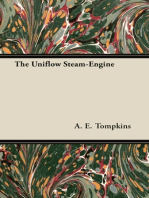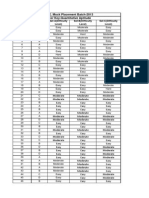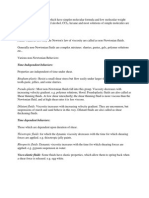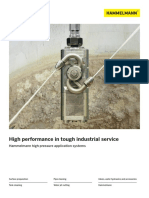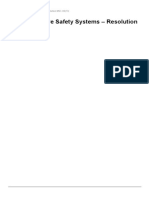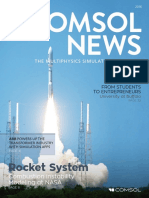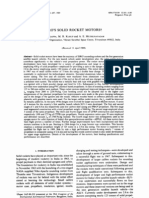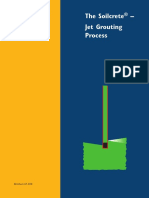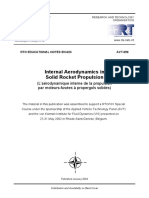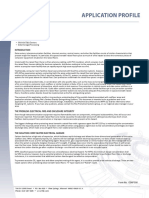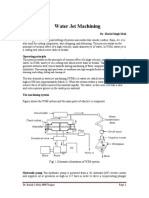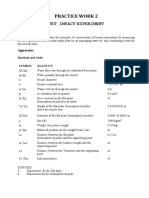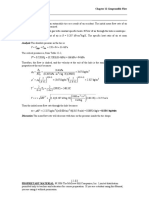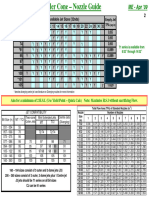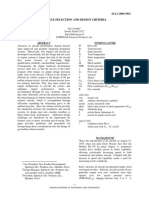Course M-3006 Steam Turbines: 5870 Highway 6 North, Suite 310 Houston, TX 77084 Toll Free: 877 500-7145
Course M-3006 Steam Turbines: 5870 Highway 6 North, Suite 310 Houston, TX 77084 Toll Free: 877 500-7145
Uploaded by
Pooja ThakkarCopyright:
Available Formats
Course M-3006 Steam Turbines: 5870 Highway 6 North, Suite 310 Houston, TX 77084 Toll Free: 877 500-7145
Course M-3006 Steam Turbines: 5870 Highway 6 North, Suite 310 Houston, TX 77084 Toll Free: 877 500-7145
Uploaded by
Pooja ThakkarOriginal Title
Copyright
Available Formats
Share this document
Did you find this document useful?
Is this content inappropriate?
Copyright:
Available Formats
Course M-3006 Steam Turbines: 5870 Highway 6 North, Suite 310 Houston, TX 77084 Toll Free: 877 500-7145
Course M-3006 Steam Turbines: 5870 Highway 6 North, Suite 310 Houston, TX 77084 Toll Free: 877 500-7145
Uploaded by
Pooja ThakkarCopyright:
Available Formats
PDHengineer.
com
Course M-3006 Steam Turbines
To receive credit for this course This document is the course text. You may review this material at your leisure either before or after you purchase the course. To purchase this course, click on the course overview page: http://www.pdhengineer.com/pages/M-3006.htm or type the link into your browser. Next, click on the Take Quiz button at the bottom of the course overview page. If you already have an account, log in to purchase the course. If you do not have a PDHengineer.com account, click the New User Sign Up link to create your account. After logging in and purchasing the course, you can take the online quiz immediately or you can wait until another day if you have not yet reviewed the course text. When you complete the online quiz, your score will automatically be calculated. If you receive a passing score, you may instantly download your certificate of completion. If you do not pass on your first try, you can retake the quiz as many times as needed by simply logging into your PDHengineer.com account and clicking on the link Courses Purchased But Not Completed. If you have any questions, please call us toll-free at 877 500-7145.
PDHengineer.com 5870 Highway 6 North, Suite 310 Houston, TX 77084 Toll Free: 877 500-7145 administrator@PDHengineer.com
Steam Turbines (3 PDH) Course No. M-3006
Introduction The invention of the reciprocating steam engine enabled man to convert the thermal energy of burning fuel to useful mechanical work, thus sparking the industrial revolution. As useful as it was, the reciprocating steam engine was still inefficient, cumbersome, had a very low power to weight ratio, and was a high maintenance piece of machinery. The development of the steam turbine was a vast improvement in all of these respects. The steam turbine led to applying many of the same principles of moving blades which ultimately led to the development of the gas turbine. All engineers should strive to learn as much as they can about the principles and features of steam and gas turbines. The vector analyses, detailed descriptions and illlustrations are adapted and reproduced from publications of the U. S. Naval Institute, Power Magazine, and Marks Handbook for Mechanical Engineers. Steam Turbines Many industries use steam turbines in a variety of applications. Capacities begin at less than one HP for mechanical drives and up to 1,000,000KW for electric power generating stations. Steam conditions run from 4,500 psig and 1,200 deg F to sub-atmospheric and 100 deg F. Steam can be supplied by boilers, heat recovery steam generators, or nuclear reactors. The expansion part of a steam cycle is where the high pressure steam from the boiler is expanded into a steam engine and the thermal energy of the steam is converted into mechanical energy, or work. A steam turbine is a type of steam engine that converts the thermal energy first to kinetic energy by expanding through nozzles or blading, and then to the rotational mechanical energy of a spinning rotor. Classifications of Steam Turbines Steam turbines can be classified in several different ways: 1. By details of stage design: Impulse or reaction. 2. By steam supply and exhaust conditions: Condensing, Non-condensing (back pressure), Automatic or controlled extraction, Mixed pressure (where there are two or more steam sources at different pressures), and Reheat (where steam is extracted at an intermediate stage, reheated in the boiler, and re-admitted at a lower turbine stage). 3. By casing or shaft arrangement: Single casing, Tandem compound (two or more casings with the shaft coupled together in line), and Cross compound (two or more shafts not in line, and possibly at different RPM).
Page 1
4. By number of exhaust stages in parallel: Two flow, four flow, six flow. 5. By direction of steam flow: Axial flow, radial flow, and tangential. 6. Single or multi-stage 7. By steam supply: Superheat or saturated. Any particular turbine may be classified by combinations of these classifications, e.g., tandemcompound, three-casing, four-flow extraction turbine. A turbine stage consists of one set of stationary blades or nozzles and an adjacent set of moving blades or buckets. (The terms "blades" and "buckets" are nearly interchangeable. The term blade or blades will be used in this course for consistency). These stationary and rotating elements act together to allow the steam flow to do work on the rotor. The work is transmitted to the load through the shaft or shafts. There are two basic models for steam turbine stage design: Impulse stage and Reaction stage. Even though most actual multi-stage turbines are combinations of these model stage designs, each will be described separately, because the theoretical differences are distinct. Impulse Turbine Stage As the steam passes through a nozzle from a high pressure pipeline to a lower pressure region, the velocity of the steam increases as the thermal energy is converted to kinetic energy. The velocity of the flow depends upon the difference in pressures between the high pressure and the low pressure regions. The weight rate of flow depends upon the velocity and the cross sectional area of the nozzle throat. This is illustrated in figure 1-2 below. The decrease in thermal energy as the steam passes through the nozzle equals the increase in kinetic energy, which is proportional to the square of the velocity. KE = WV / 2g Where KE = kinetic energy in ft lb W = weight of the steam in lb V = velocity of the steam in ft/sec g = 32 ft /sec
If an obstruction, such as a turbine blade, is placed in the path of the flowing steam, the steam will exert a force, or an "impulse" on the blade in an amount equal to the weight rate of flow and the velocity of the steam. As the blade moves due to this force, work is performed on the blade in an amount equal to the force times the distance the blade moves due to this force. If the blade is one of a series of such blades connected to a rotor, the rotor will spin as the continuous flow of steam
Page 2
impinges on each successive blade. Such a device would constitute a simple form of a turbine called an impulse turbine. This action is illustrated in figures 1-2 and 1-3 below.
Page 3
In order to obtain the maximum amount of work from the steam, all of its kinetic energy must be converted to work. In other words, the steam must leave the blade with zero absolute velocity. Assuming a frictionless blade, the velocity of the steam relative to the blade must be the same entering as leaving, but reversed in direction. Also, the blade velocity must be one half of the entering steam velocity. (Refer to figure 1-3). There are actually two different forces acting on the blade. The first is the force of the steam jet striking the blade, as described. The second is the reactive force due to the change in direction of the steam flow between the entrance and exit from the blade. In actual turbines, it is impractical to utilize the full advantage of complete reversal of the steam. In a conventional impulse stage, the blades project radially from the wheel and the nozzles are placed so that the steam flow is at an angle to the plane of rotation. (Shown in figure 1-4).
Page 4
Page 5
The pressure and velocity changes taking place are shown in figure 1-4. The only pressure drop occurs in the nozzle. The pressure entering the blades is the same as that leaving the blades. Velocity Vector Diagram for Impulse Stage Figure 1-5a is a velocity vector diagram for a single row of impulse blades to which the following nomenclature applies: Note that the "alpha, beta, and gamma" in the figure are represented as "a, B, and y, respectively, in the text. a = steam entrance angle V1 = abs. vel. steam entrance B = blade entrance angle V2 = relative vel. steam entrance y = blade exit angle V3 = relative vel. steam exit Vb = blade vel.; V4 = abs. vel. steam exit
The component of absolute steam entrance velocity V1 in the direction of blade motion is shown by the vector FA = V1 cos a, =V2 cos B +Vb. The smaller the angle (a) can be made, the larger the
Page 6
component will be. Since it is only this component that does work on the blades, the steam entrance angle (a) is made as small as mechanical conditions permit. It varies between 12 degrees and 25 degrees. Futhermore, the more nearly complete the steam reversal is, the more work will be done on the blades. It is also necessary, therefore, to make the blade exit angle (y) as small as possible. It has been previously stated that in order to obtain maximum work from the steam jet striking a reversing blade, the steam must leave the blade with an absolute zero velocity. This condition cannot be realized with anything less than a complete reversal of the steam flow, so in a real situation, there must be a positive exit velocity, as represented by the vector V4 in the diagram. To minimize the exit velocity, V4 must be perpendicular to Vb, as shown in the diagram. For this condition, V2 = V3, and angle (B) must equal angle (y). If you work through the geometry, you will find that the maximum work results from impulse blading when the steam enters the blades at angle (a), the blade speed must equal 1/2 cos (a) times the absolute steam entrance velocity. Force Vector Diagram for Impulse Stage Now consider the force vector diagram of figure 1-5b. A mass of steam entering a row of moving blades with a relative velocity V2 will have a momentum which will exert an impulse force F1 in the direction V2. The same mass of steam leaving the row of moving blades with a relative velocity V3 will exert a reactive force F2 on the blade opposite to the direction of V3. If V2 is equal to V3 in magnitude, assuming no friction between the steam and the blade, and if the blade entrance angle (B) is equal to the blade exit angle (y), the components T1 and T2 will be equal and opposite, and the resultant will produce zero axial thrust on the turbine wheel. In actual design, angle (y) is made slightly larger than angle (B) to account for friction between steam and blade.
Page 7
Simple Impulse Turbines The vector analysis above indicates that the maximum work is obtained from an impulse stage when the blade speed equals 1/2 of the steam entrance velocity times the cosine of the steam entrance angle. In almost all practical situations this would result in a blade speed too high for the structural limitations imposed by available materials. The blade speed must therefore be restrained by the load on the turbine. Hence, the speed limiting governors and over speed trips found on all turbines. This reduction in blade speed results in the blade not absorbing the maximum amount of kinetic energy of the steam, and the steam will leave the blades with a relatively high velocity, as well as a lowering of efficiency. The ratio of actual blade speed to ideal blade speed is the indication of efficiency. In spite of the lower efficiency of a simple impulse turbine, its simplicity of design and construction makes it suitable for small auxiliary turbines. Such a turbine is illustrated in figure 2-3a. The simple impulse stage is sometimes called a Rateau stage. Notice the equalizing hole in the turbine wheel. This is to ensure zero pressure differential across the wheel. Remember, a distinguishing characteristic of an impulse stage is no pressure drop across the blades.
Page 8
Velocity Compounded Impulse Turbine To improve the low efficiency of the simple impulse turbine caused by its low actual-to-ideal blade speed ratio, two or more rows of moving blades may be mounted on the periphery of the single rotating wheel, with suitable fixed guide blades attached to the casing between the rows of moving blades. Expansion of the steam takes place through a single set of nozzles as in the simple impulse turbine. After passing through the first set of moving blades, the steam, which still has high velocity, passes through a row of fixed guide blades, which directs the flow to a second row of moving blades. It is usual to have two rows of moving blades in a single stage of this type, although as many as five rows of moving blades have been used. By working through a vector analysis (as was done for the simple impulse turbine), it can be shown that the ideal blade speed for the two row impulse turbine is 1/4 of the entering steam speed, instead of 1/2 of the entering steam speed. Likewise, by adding more rows of moving and fixed blades, ideal blade speed can be reduced to 1/6 or 1/8, etc. of the entering steam speed. As the ratio of actual to ideal blade speed increases, that is, the ideal blade speed decreases, the turbine efficiency increases. Such a turbine is a velocity compounded impulse turbine.
Page 9
Pressure Compounded Impulse Turbine Instead of causing the total drop in steam pressure to occur in one set of nozzles as in the simple and velocity compounded machines just discussed, the pressure drop may be divided into two or more steps. The result is a number of simple impulse turbines arranged in series. The steam leaving the first row of moving blades goes through a second row of fixed nozzles, then to a second row of moving blades, and so on. Since a single pressure drop occurs in each set of nozzles, each combination of nozzles and succeeding row of blades constitutes a stage. This type of turbine is, therefore, a multi-stage turbine. Since the turbine is a compound series of pressure stages, it is termed a pressure-compounded impulse turbine. Again, the pressure drop occurs only in the nozzles. The total pressure drop from steam chest to exhaust is divided into as many pressure drops as there are stages. This results in a relatively low pressure drop per stage, and therefore a relatively low steam entrance velocity for each stage. If a sufficient number of pressure stages are used, an ideal blade speed can be reached that is within the practical blade velocity limitations. Pressure-Velocity-Compounded Turbine When both velocity and pressure compounding occurs within the same turbine, we have a pressure-velocity-compounded turbine. The velocity compounding stage is always at the high pressure end in order to absorb in a single stage a large portion of the total pressure and temperature drop of the steam. The rest of the turbine may consist of pressure compounded stages. Such an arrangement is called a Curtis turbine.
Reaction Stage A fluid expanding as it passes through a nozzle increases in velocity and exerts a reactive force in a direction opposite to the direction of flow. As mentioned in the description of the impulse stage, this force exists as the steam exits the impulse blading, but is secondary to the impulse force. In a reaction stage, a row of fixed blades takes the place of the impulse stage nozzles, and directs the steam to an adjacent row of moving blades. The moving blades of a reaction stage are shaped to take full advantage of the reactive force. That is, they are shaped so as to create a nozzle effect in the space between the blades (an increase of steam velocity relative to the moving blades). The
Page 10
primary force exerted on the moving blade wheel is then the reactive force, rather than the impulse force.
Page 11
The reaction stage velocity vector diagram is shown in figure 1-7a. The following nomenclature applies, with a, B, and y represented by alpha, beta, and gamma on the diagram: a = steam entrance angle B = blade entrance angle y = blade exit angle Vb = blade velocity V1 = absolute velocity steam entrance V2 = relative velocity steam entrance V3 = relative velocity steam exit
As in the impulse turbine, the component of absolute steam entrance velocity V1 in the direction of blade motion is shown by the vector FA = V1 cos (a), = V2 cos B + Vb. For a pure reaction blade, V2 cos B , which is the component of relative steam entrance velocity in the direction of blade motion must be equal to zero, that is, angle (B) must equal 90 deg in order that there be no impulse force acting on the moving blade. Due to the expansion of the steam as it moves through the blades, the relative exit velocity V3 is greater than the relative entrance velocity V2. If the blades are considered frictionless, and if the drops in enthalpy across the fixed and moving blades are equal, and angle (a) equals angle (y), the V1 = V3 and V2 = V4. In order to obtain maximum work from the blades, vector V4, the absolute steam exit velocity must be at a minimum since it does no work. This minimum is obtained when V4 is perpendicular to Vb. Since V3 = V1, the condition of maximum work is obtained when Vb = V1 cos (a).
Page 12
Force Vector Diagram for Reaction Stage
The reaction force exerted on the moving blade by the exit steam F2 is composed of two parts; the force due to change of direction within the blades (F2'), and the force due to the increase in magnitude of the steam velocity within the blades (F2''). F2' may be resolved into an orthagonal component of a reactive force due to the change in direction (R2'), and an axial thrust (T2'). F2'' may be resolved into a reactive force due to the change in velocity magnitude (R2''), and an axial thrust (T2''). The resultant of T2' and T2'' is an axial thrust opposite to the direction of steam flow through the turbine (T2). In a pure reaction stage, angle (B) is 90 deg as shown in figure 1-7a. In a practical reaction turbine, angle (B) must be somewhat less than 90 deg. So the entrance steam exerts the force F1 (fig. 1-7b), which may be resolved into a component of axial thrust (T1), and an impulse component due to the entrance steam velocity (R1). By design, T1 and T2 may be made about equal in magnitude, and since they are opposite in direction, their resultant will cause zero axial thrust. There exists, however, a third force (F3), which causes an axial thrust in a reaction turbine. As the steam passes through the blades, it drops in pressure, unlike the blades of an impulse. This results in a considerable difference in pressure between the entrance and exit sides of the row of moving blades. This pressure differential exerts a thrust in the direction of steam flow, which is unopposed by any force acting in the opposite direction. For this reason, in reaction turbines there always exists an unbalanced axial thrust in the direction of steam flow. In order to keep the turbine rotor in its correct axial position, this unbalanced steam thrust must be compensated. One way of compensating for this axial thrust is to design it so the steam enters at the middle of the turbine and flows toward each end. Such an arrangement is called a two-flow, or double-exhaust flow turbine. Two flow turbines are common for the low pressure casing of a multi-casing turbine.
Page 13
All reaction turbines are pressure compounded; that is, they are so arranged that the pressure drop is distributed, stage by stage from inlet to exhaust. Therefore, the pressure drop in each stage is relatively small, resulting in a lower steam velocity for each stage and a lower ideal blade velocity. Reaction turbines are sometimes called Parsons turbines. Combination Turbines In actual practice, there are few purely impulse or purely reaction multi-stage turbines. As the steam expands from inlet to exhaust end, and the blades become longer, the tendency is for the blades to be more nearly impulse at the inner diameter and more nearly reaction at the outer diameter. The Curtis turbine has been previously mentioned where a velocity compounded impulse stage is followed by a series of pressure compounded impulse stages. The same idea can be carried out by following a single velocity compounded impulse stage with a series of reaction stages. The straight reaction turbine is at a disadvantage with high temperatures and pressures. At high pressures, the first stage blades are so small that tip leakage is excessive, reducing efficiency. In addition, high temperatures are maintained as the inlet steam passes through reaction stages, requiring more expensive material. If a Curtis impulse stage is used at the inlet end, it will effect a large temperature and pressure drop in the first stage nozzles, enabling the successive reaction stages to be subjected to lower pressure and temperature differentials. Another disadvantage of a reaction stage at the steam inlet end is that the steam must be admitted to the full circumference of the fixed blades, and turbine control therefore is accomplished by a throttle valve. The throttling process is inefficient. If the first stage is an impulse stage, the steam can be admitted by successively opening nozzles as the load is increased, thereby admitting steam to portions of the moving blade wheel proportional to the turbine load. This is called partial arc admission, and is more efficient than using a throttle valve and full arc admission. (An exception to this principle is variable, or sliding pressure operation, whereby the turbine power is controlled by varying the boiler pressure and admitting the steam through the full arc of the turbine first stage). Turbine Losses In actual practice, not all of the energy in the steam is converted to useful work. Losses common to all turbines are described below:
Loss of working substance. Loss of steam along the shaft through the shaft glands where the shaft penetrates the casing.
Page 14
Work loss. Loss due to mechanical friction between moving parts. Throttling loss. Wherever there is a reduction in steam pressure without a corresponding production of work, such as in a throttle valve. Leaving loss. The kinetic energy of the steam leaving the last stage blading. This leaving loss can be minimized by lightly loading the last stage blading by increasing the annular exhaust area of the turbine. This is often optimized through economic studies. Windage loss. This is caused by fluid friction as the turbine wheel and blades rotate through the surrounding steam. Friction loss as the steam passes through nozzles and blading. Diaphragm packing loss as the steam passes from one stage to another through the diaphragm packing. Tip leakage loss in reaction turbines as steam passes over the tips of the blades without doing any useful work. Comparison of Impulse and Reaction Turbines At this point, it is well to distinguish clearly between the terms impulse and reaction as applied to steam turbine blading. Within any one stage of an impulse turbine, the only pressure drop is that which occurs in the nozzles. Regardless of the number of fixed and moving blades, the pressure always stays the same throughout the blading. The effect of the jet of steam upon the blading is that of dynamic pressure, and is independent of any expansion of the steam. A stream of any kind of particles, such as sand or shot, if traveling at the same speed, would have the same general effect. The passage between adjacent blades is normally uniform in cross sectional area, since the function is only to change direction of the steam. Any slight pressure difference which might develop is equalized by the equalizing holes drilled in the turbine wheels. In the reaction turbine, the stationary blades perform the same function as the nozzles in an impulse turbine. The curved passages of the moving blades not only absorb some of the energy of the steam delivered to them by the ring of fixed blading, but also generate additional kinetic energy by allowing an expansion between themselves. Some of this energy is absorbed by the moving blades, and the steam leaves the moving blades with approximately the same velocity of that with which it entered the fixed blades. Because they too permit expansion of the steam, the passages between the moving blades are of similar shape to those between the fixed blades. In fact, the stationary and moving blades within each stage are identical in shape of cross section.
Page 15
Turbine Classification by Steam Supply and Exhaust Conditions There are some applications where the steam may be supplied at different pressures. A common example is the heat recovery steam generator (HRSG) of a combined cycle cogeneration plant. The HRSG uses the thermal energy in the exhaust of a gas turbine, sometimes augmented by additional burners. An HRSG may have two or more steam drums which supply steam at different pressures, either for industrial or district heating purposes or for injection into a turbine at various stages to increase electric power generation. Turbines may also have steam extracted at intermediate stages prior to exhaust for feedwater heating or other auxiliary uses in a power plant or for industrial or heating purposes. This extraction may be automatic (uncontrolled), as for regenerative feedwater heating, or controlled by throttling for other demands. Extraction lines are equipped with non-return valves to prevent turbine over speed in case of a turbine trip and to prevent water injection from feedwater heaters. Turbines whose main purpose is to generate electric power generally exhaust to a condenser at a negative pressure in order to extract the maximum energy from the steam. Turbines may also be used in a so called "topping cycle", where the steam exhausts at a useful positive pressure to serve another purpose. These may be called backpressure turbines. Turbine Classification by Casing Arrangement Turbines may be classified as to the number of casings the steam passes. There are two basic types of flow: 1. Single flow 2. Compound flow: (a) Cross compound; (b) Tandem compound In a single flow turbine, all the steam expansion that produces work takes place in a single casing. This is normally applicable to auxiliary turbines where power requirements are relatively small. Where power requirements are large, it is usually impracticable to design and construct a turbine where all of the work can be extracted from the steam within a single casing. Large electric power generating turbines commonly have a high pressure casing, which receives superheated steam directly from the boiler or steam generator. The high pressure turbine may then exhaust to an intermediate pressure turbine, or may pass back to a reheat section in the boiler before passing to a reheat intermediate pressure turbine. The reheat turbine may then exhaust to one or more low pressure casings, which are usually two exhaust flow turbines, with the low pressure steam entering the middle of the turbine and flowing in opposite directions toward two exhaust end before passing into the condenser. When the turbine casings are arranged on a single shaft, the turbine is said to be tandem compounded. In cross compound turbines, the high-pressure, exhaust passes over to intermediate or low pressure casings which are mounted on separate shafts. The two shafts may drive separate loads,
Page 16
or may be geared together to a single load. Ship propulsion plants commonly employ cross compounded turbines in order to shorten the length which would be required for tandem casings. Classification by Direction of Steam Flow Turbines may be classified according to the direction of steam flow in relation to the turbine wheel or drum. The great majority of turbines, especially those of high power, are axial flow. In such turbines the steam flows in a direction or directions parallel to the axis of the wheel or rotor. The discussions so far in this course have been with axial turbines in mind. A turbine may also be constructed so that the steam flow is in a radial direction, either toward or away from the axis. The figure below illustrates an impulse, radial flow, auxiliary turbine such as may be used as a pump drive.
In a tangential, or helical flow turbine (illustrated below), the rotating element consists of a wheel having semi-circular slots called "buckets" which are milled obliquely in the periphery. The nozzles are located around the periphery of the wheel in such a way that the steam flows from them in a direction approximately tangential to the wheel and into the buckets, giving a rotational impulse to the wheel. The direction of steam flow is reversed in the buckets, and the steam flows out on the opposite side from which it entered. The direction is again reversed by a redirecting bucket, and it flows again through the moving buckets, this process being repeated several times, after which the steam passes out through the exhaust opening. The turbine is a single stage impulse unit, since the only pressure drop occurs in the nozzles, but has velocity compounded characteristics. A nozzle and the accompanying set of redirecting buckets are cast in one piece, and any number of these nozzle sets may be installed up to the limit imposed by the circumference of the wheel. This
Page 17
type of turbine is built only in small units, and is used primarily to drive auxiliary machinery. It has reasonably high efficiency over a wide range of speeds, so is especially adaptable to machinery requiring large speed variations.
Conclusion This completes the presentation on the basic principles of steam turbines and their applications. Further information on the thermodynamics of steam turbines, their part in the optimization of the steam cycle, and turbine accessories will be covered in future courses. Hopefully, this course has provided a useful review of steam turbines and furthered the understanding of these basic pieces of industrial machinery.
Page 18
You might also like
- Filter Separator SizingDocument3 pagesFilter Separator SizingChem.Engg100% (2)
- Steam Turbines and Gearing GJ Roy PDFDocument48 pagesSteam Turbines and Gearing GJ Roy PDFHarpreet Singh50% (2)
- Chinese Word List HSK Level1Document10 pagesChinese Word List HSK Level1Pooja ThakkarNo ratings yet
- Cangas Manual - enDocument41 pagesCangas Manual - enDaniel BarbuNo ratings yet
- 05 Steam TurbineDocument11 pages05 Steam TurbineJohn Paulo ArchinueNo ratings yet
- Steam TurbineDocument27 pagesSteam TurbinePrakashKr100% (2)
- ME66-Plate2 CASERESDocument17 pagesME66-Plate2 CASERESVan Eldridge Kyle CaseresNo ratings yet
- Steam Turbines: Prepared by Venkat Chintala Asst. Prof. S.G. Mechanical Engg. Deptt., UPESDocument85 pagesSteam Turbines: Prepared by Venkat Chintala Asst. Prof. S.G. Mechanical Engg. Deptt., UPESRaj NarayanNo ratings yet
- Steam Turbine and Its GoverningDocument6 pagesSteam Turbine and Its Governingpatel_nirav1992100% (2)
- Unit 7 GGDocument24 pagesUnit 7 GGAbhijeeth Nagaraj100% (2)
- Steam and Gas TurbinesDocument17 pagesSteam and Gas TurbinesShrinidhi KNo ratings yet
- Types and Working Principles Steam TurbinesDocument69 pagesTypes and Working Principles Steam TurbinesSurajit Banerjee100% (2)
- '' Turbine - Nozzle - Diffuser - Compressor ''Document15 pages'' Turbine - Nozzle - Diffuser - Compressor ''Eng-Ahmed Salama100% (1)
- Critical Speed of TurbineDocument8 pagesCritical Speed of Turbinezeon100% (4)
- 05 Steam TurbineDocument14 pages05 Steam TurbineAndreau BienNo ratings yet
- Chapter 8Document33 pagesChapter 8birlieNo ratings yet
- Chapter 6Document16 pagesChapter 6Sai BiswajitNo ratings yet
- Otaword ManualDocument199 pagesOtaword ManualRaja RamNo ratings yet
- Steam TurbineDocument34 pagesSteam TurbineKRISHNA KANT GUPTA100% (1)
- Unit 4 (Reaction Turbines.) 1Document12 pagesUnit 4 (Reaction Turbines.) 1amarparimiNo ratings yet
- MODULE 3 Cascade Theory, Axial Flow Turbine and Propulsion SystemDocument43 pagesMODULE 3 Cascade Theory, Axial Flow Turbine and Propulsion SystemantonNo ratings yet
- Gas TurbineDocument12 pagesGas Turbinemonu1312No ratings yet
- Chapter-5 Steam TurbineDocument26 pagesChapter-5 Steam Turbinehadush gebre100% (1)
- MODULE 3 Cascade Theory, Axial Flow Turbine and Propulsion System PDFDocument43 pagesMODULE 3 Cascade Theory, Axial Flow Turbine and Propulsion System PDFantonNo ratings yet
- 03 - Steam Turbines Types PDFDocument49 pages03 - Steam Turbines Types PDFVimleshKumarSharma100% (2)
- Lecture 9: Steam Turbines - Impulse TurbineDocument8 pagesLecture 9: Steam Turbines - Impulse TurbineIjazzzAliNo ratings yet
- Chapter Four: Steam TurbineDocument23 pagesChapter Four: Steam TurbineTaha KhanNo ratings yet
- Chapter Four: Steam TurbineDocument23 pagesChapter Four: Steam Turbineserverbek0527No ratings yet
- Turbine Lab ReportDocument11 pagesTurbine Lab ReportIzzul Hazim75% (8)
- Clasification of Steam TurbinesDocument16 pagesClasification of Steam TurbinesDeepu ChoudharyNo ratings yet
- 1966 - Jachens - Steam Turbines Their ConstructionDocument19 pages1966 - Jachens - Steam Turbines Their Constructionanuragriles100% (1)
- Me Ee-411 Term Paper TH Engg (Copy)Document7 pagesMe Ee-411 Term Paper TH Engg (Copy)PRANAB KUMAR PALNo ratings yet
- Chap 6 Reaction TurbineDocument10 pagesChap 6 Reaction TurbineSourabh SalunkheNo ratings yet
- Unit - 4: Hydraulic Turbuines:) : It Is Defined As The Ratio of Power Developed by The Runner To The PowerDocument11 pagesUnit - 4: Hydraulic Turbuines:) : It Is Defined As The Ratio of Power Developed by The Runner To The PowerTanu Rd100% (1)
- Steam Turbine IIDocument11 pagesSteam Turbine IIg9958306No ratings yet
- Assignment Questions ME603 (A) TurbomachineryDocument21 pagesAssignment Questions ME603 (A) Turbomachineryगौरव साहूNo ratings yet
- Chapter-1 Steam Turbine TheoryDocument17 pagesChapter-1 Steam Turbine Theorybhaskar100% (1)
- Steam TurbineDocument16 pagesSteam TurbineVinayakNo ratings yet
- Unit 1Document18 pagesUnit 1maheshNo ratings yet
- Steam Turbine DesignDocument27 pagesSteam Turbine DesignEkta Gupta50% (2)
- Thermodynamics Steam TurbineDocument8 pagesThermodynamics Steam TurbineidhammenderoNo ratings yet
- Chap6 7 PPT 171128132742 - 2 PDFDocument58 pagesChap6 7 PPT 171128132742 - 2 PDFHabtamu Tkubet Ebuy100% (1)
- (6.2) Steam TurbineDocument21 pages(6.2) Steam TurbineKRISHNA KANT GUPTANo ratings yet
- Unit 3 (Steam Turbines)Document29 pagesUnit 3 (Steam Turbines)amarparimiNo ratings yet
- Steam Turbine CyclesDocument55 pagesSteam Turbine Cyclesmishraengg100% (2)
- Unit 3 (Steam Nozzles)Document20 pagesUnit 3 (Steam Nozzles)amarparimi50% (4)
- Steam Turbine: AdvantagesDocument6 pagesSteam Turbine: AdvantagesMahi100% (1)
- Unit-Iii: Steam Nozzles and TurbinesDocument26 pagesUnit-Iii: Steam Nozzles and TurbinesNalliah PrabakaranNo ratings yet
- DPDocument21 pagesDPDivya Prakash SrivastavaNo ratings yet
- Steam Turbine DesignDocument14 pagesSteam Turbine DesignFaiz de PorrasNo ratings yet
- Turbine - WikipediaDocument7 pagesTurbine - WikipediaKiran KotinNo ratings yet
- Steam TurbinesDocument14 pagesSteam Turbinesshashanksir88% (8)
- Exp 7 & 8 Data For WritingDocument17 pagesExp 7 & 8 Data For Writingkhizeraftab1018No ratings yet
- Steam Turbine Electricity Generation Plants: Aeolipile, A ReactionDocument10 pagesSteam Turbine Electricity Generation Plants: Aeolipile, A ReactionDaniel YoworldNo ratings yet
- Note 1455804851Document27 pagesNote 1455804851Ajith KumarNo ratings yet
- Turbine PrincipleDocument57 pagesTurbine PrincipleSheikh Zakir100% (2)
- The Petrol Engine: A Text-book dealing with the Principles of Design and Construction, with a Special Chapter on the Two-stroke EngineFrom EverandThe Petrol Engine: A Text-book dealing with the Principles of Design and Construction, with a Special Chapter on the Two-stroke EngineNo ratings yet
- VocabDocument1 pageVocabPooja ThakkarNo ratings yet
- Upcoming Hotel Projects in IndiaDocument5 pagesUpcoming Hotel Projects in IndiaPooja ThakkarNo ratings yet
- L.D.C.E. Mock Placement Batch-2013 Answer Key-Quantitative AptitudeDocument2 pagesL.D.C.E. Mock Placement Batch-2013 Answer Key-Quantitative AptitudePooja ThakkarNo ratings yet
- Ikea Facts, Figures, StrategiesDocument3 pagesIkea Facts, Figures, StrategiesPooja ThakkarNo ratings yet
- Clash of CivilizationsDocument28 pagesClash of CivilizationsPooja ThakkarNo ratings yet
- Carson Rachel LousieDocument6 pagesCarson Rachel LousiePooja ThakkarNo ratings yet
- Non-Newtonian Fluids:: Time-Independent BehaviorsDocument1 pageNon-Newtonian Fluids:: Time-Independent BehaviorsPooja ThakkarNo ratings yet
- Optimization of Ammonia Absorption Using Acid Spray Wet ScrubbersDocument14 pagesOptimization of Ammonia Absorption Using Acid Spray Wet ScrubbersSong Nguyen NguyenNo ratings yet
- NozzlesDocument16 pagesNozzlesZain Ul AbideenNo ratings yet
- High Pressure Application Systems PDFDocument35 pagesHigh Pressure Application Systems PDFMin MCLNo ratings yet
- Of of ofDocument24 pagesOf of ofAIEIMANo ratings yet
- Assignment 2Document2 pagesAssignment 2Lovish ChopraNo ratings yet
- Subsonic and Supersonic Air IntakesDocument68 pagesSubsonic and Supersonic Air IntakesSanjay SinghNo ratings yet
- An Article On Tank Bulging Effect or Bulging Effect of Tank ShellsDocument4 pagesAn Article On Tank Bulging Effect or Bulging Effect of Tank ShellsSanjeev KumarNo ratings yet
- Modeling For Shell-Side Pressure Drop For Liquid Flow in Shell-And-Tube Heat ExchangerDocument10 pagesModeling For Shell-Side Pressure Drop For Liquid Flow in Shell-And-Tube Heat ExchangerAhmad Restian Adi NugrohoNo ratings yet
- FSS Code - Fire Safety Systems PDFDocument73 pagesFSS Code - Fire Safety Systems PDFOcean going master Cpt. batuNo ratings yet
- RM SeminarDocument21 pagesRM SeminarEsskindirNo ratings yet
- Rocket System: Combustion Instability Modeling at NASADocument40 pagesRocket System: Combustion Instability Modeling at NASAlucignolo71No ratings yet
- Isro'S Solid Rocket Motorst: Acta Astronautica Vol. 19, No. 8, Pp. 681 97, 1989Document17 pagesIsro'S Solid Rocket Motorst: Acta Astronautica Vol. 19, No. 8, Pp. 681 97, 1989Korhan CoskunNo ratings yet
- BernoulliDocument12 pagesBernoullijegaNo ratings yet
- The Soilcrete - Jet Grouting ProcessDocument12 pagesThe Soilcrete - Jet Grouting ProcesssuvraNo ratings yet
- Low Expansion Foam NozzlesDocument2 pagesLow Expansion Foam Nozzleshappale2002No ratings yet
- Internal Aerodynamics in Solid Rocket Propulsion - 2004Document468 pagesInternal Aerodynamics in Solid Rocket Propulsion - 2004Alexandre Pereira100% (2)
- Fluidized Bed Jet MillDocument5 pagesFluidized Bed Jet Milln73686861No ratings yet
- Fuel Injection Valve Testing and MaintenanceDocument8 pagesFuel Injection Valve Testing and MaintenancepaulNo ratings yet
- CDAP006 Subfloor Protection PDFDocument2 pagesCDAP006 Subfloor Protection PDFGustavo Márquez TorresNo ratings yet
- Water Jet Machining: Dr. Harlal Singh MaliDocument12 pagesWater Jet Machining: Dr. Harlal Singh MaliAdit AgarwalNo ratings yet
- Practice Work 2: Jet Impact ExperimentDocument5 pagesPractice Work 2: Jet Impact ExperimentPhaNith EmNo ratings yet
- FM Sol Chap12-131Document41 pagesFM Sol Chap12-131CEMONo ratings yet
- RC - Nozzle Guide - Smith BitsDocument8 pagesRC - Nozzle Guide - Smith BitsGharib HashemNo ratings yet
- Nozzle Selection and Design CriteriaDocument11 pagesNozzle Selection and Design CriteriajbmccavalcantiNo ratings yet
- Aircraft DesignDocument76 pagesAircraft Designmilanmitic3No ratings yet
- Float Level Switch Specification - AFC-1 (ALL)Document8 pagesFloat Level Switch Specification - AFC-1 (ALL)Phạm Tấn PhướcNo ratings yet
- Optimizing Spent Catalyst StrippingDocument3 pagesOptimizing Spent Catalyst Strippingadalvarado_238071No ratings yet
- Compressible Aerodynamics - Chapter10 - v2 PDFDocument35 pagesCompressible Aerodynamics - Chapter10 - v2 PDFPythonraptorNo ratings yet









